Pacific Salmon and Steelhead
Pacific Salmon and Steelhead
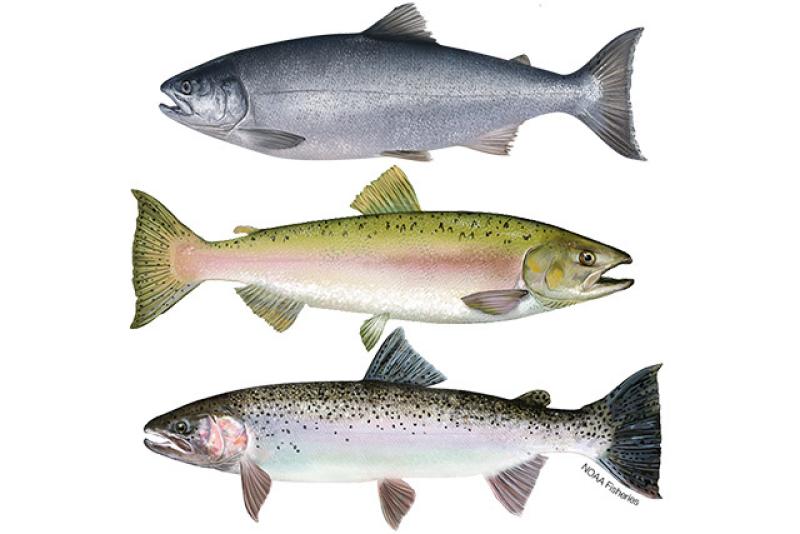
Quick Facts
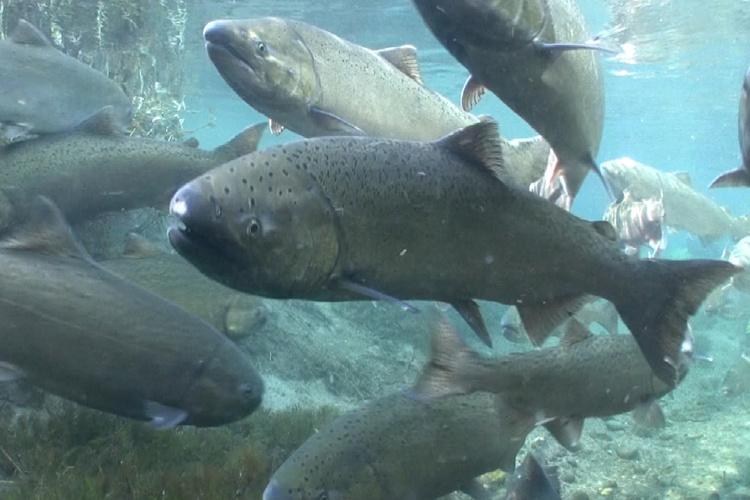 Spring Chinook Salmon. Credit: Michael Humling, U.S. Fish & Wildlife Service
Spring Chinook Salmon. Credit: Michael Humling, U.S. Fish & Wildlife Service
Spring Chinook Salmon. Credit: Michael Humling, U.S. Fish & Wildlife Service
About
 Spring Chinook Salmon. Credit: Michael Humling, U.S. Fish & Wildlife Service
Spring Chinook Salmon. Credit: Michael Humling, U.S. Fish & Wildlife Service
Spring Chinook Salmon. Credit: Michael Humling, U.S. Fish & Wildlife Service
Pacific salmon and steelhead have a dynamic life cycle that includes time in fresh and saltwater habitats. These fish are born in freshwater streams and rivers, migrate to coastal estuaries, then enter the ocean where they mature. They usually return as adults to the same streams where they were born to spawn and begin the cycle again.
NOAA Fisheries manages and protects several species of fish in the Salmonidae family in both the Atlantic and Pacific. Some are threatened or endangered and protected under the Endangered Species Act. Others are targeted by commercial and recreational fisheries and are managed under the Magnuson-Stevens Act to maintain healthy, sustainable population levels.
Pacific salmon and steelhead include the following species:
Chinook Salmon
Chum Salmon
Coho Salmon
Sockeye Salmon
Pink Salmon
Steelhead Trout
Learn about our work to manage and protect salmon and steelhead in the Pacific Northwest:
Last updated by NOAA Fisheries on 09/12/2024
Featured News
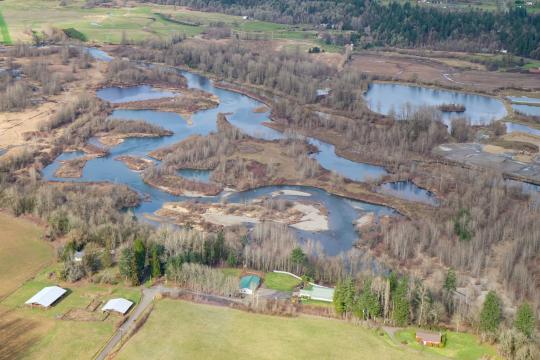 Aerial view of the Ridgefield Pits in the foreground on the East Fork Lewis River before restoration. The Daybreak Pits can also be seen and are located adjacent to the Ridgefield Pits. The project will focus on restoring the nine Ridgefield Pits. Credit: Lower Columbia Estuary Partnership
Aerial view of the Ridgefield Pits in the foreground on the East Fork Lewis River before restoration. The Daybreak Pits can also be seen and are located adjacent to the Ridgefield Pits. The project will focus on restoring the nine Ridgefield Pits. Credit: Lower Columbia Estuary Partnership
Washington State River Restoration Project to Revive Salmon Habitat, Support Local Jobs
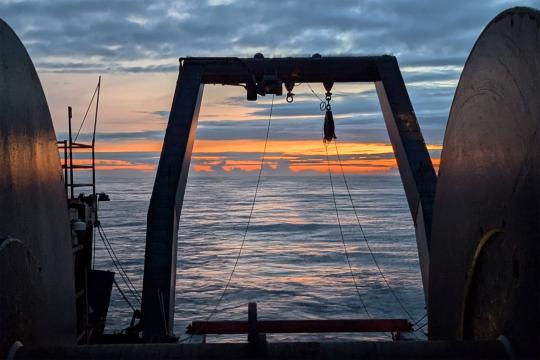 The sun sets over the net reel of the NOAA ship Bell M. Shimada. Credit: NOAA Fisheries
The sun sets over the net reel of the NOAA ship Bell M. Shimada. Credit: NOAA Fisheries
El Niño Yields to Upwelling in the California Current, Renewing Productivity of West Coast Ecosystem
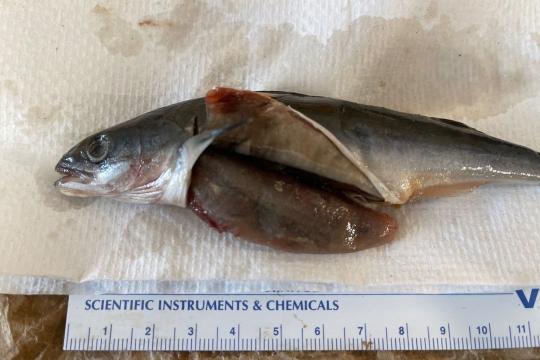 Scientists examined the stomach contents of juvenile sablefish in coastal waters, finding evidence of their voracious appetite including other fish almost as big as they are. Photo by Elizabeth Daly/CIMERS.
Scientists examined the stomach contents of juvenile sablefish in coastal waters, finding evidence of their voracious appetite including other fish almost as big as they are. Photo by Elizabeth Daly/CIMERS.
Young Salmon May Face Hungry New Competition from Juvenile Sablefish along Northwest Coast
 York Creek flows free after removal of York Dam reopened the upper reaches of the creek to Central California Coast steelhead after nearly a century. Photo by Brian Meux/NOAA Fisheries.
York Creek flows free after removal of York Dam reopened the upper reaches of the creek to Central California Coast steelhead after nearly a century. Photo by Brian Meux/NOAA Fisheries.
Four Pacific Salmon and Steelhead Retain Threatened Status in Reviews of Recovery Progress
Alaska Fisheries
Salmon fisheries provide for commercial, sport, subsistence, and tribal harvest in ocean and inland waters of Alaska. Steelhead are harvested in sport and subsistence fisheries.

Salmon Fisheries
The North Pacific Fishery Management Council manages salmon fisheries of the U.S. Exclusive Economic Zone (EEZ) off Alaska under the Magnuson-Stevens Act to maintain healthy, sustainable population levels. The Council developed the Fishery Management Plan for Alaskan Salmon Fisheries (Salmon FMP) in the EEZ off Alaska under the MSA.
The Salmon FMP allows a commercial troll fishery in the EEZ off Southeast Alaska, and closes the remaining EEZ off Central and Western Alaska to commercial salmon fishing. All other salmon fishing occurs in State of Alaska managed waters (inside 3 nautical miles) or in one of three historical state-managed net fishing areas that extend into the EEZ. The Salmon FMP does not cover the fisheries in these three state-managed fishing areas:
- Cook Inlet
- Prince William Sound
- Alaska Peninsula
The Salmon FMP delegates management of the commercial troll fishery in Southeast Alaska to the State of Alaska and, under the Pacific Salmon Treaty, the U.S.-Canada Pacific Salmon Commission. The Southeast Alaska troll fishery is a mixed-stock, mixed-species fishery that primarily targets chinook salmon (Oncorhynchus tshawytscha) and coho salmon (O. kisutch), with pink salmon (O. gorbuscha), chum salmon (O. keta), and sockeye salmon (O. nerka) taken incidentally.
NOAA Fisheries' West Coast Region has jurisdiction over the salmon species listed as endangered or threatened under the Endangered Species Act.
Learn more about Alaska salmon fisheries
Steelhead Fisheries
Steelhead are managed by the State of Alaska. They are harvested in state sport and subsistence fisheries.
Last updated by NOAA Fisheries on 09/12/2024
West Coast Fisheries
NOAA Fisheries works in cooperation with federal, state, tribal, and Canadian officials to manage salmon and steelhead fisheries in ocean and inland waters of Washington, Oregon, Idaho, and California. These fisheries are managed under the Magnuson-Stevens Act to maintain healthy, sustainable population levels.

Ocean Salmon Fisheries
NOAA Fisheries works with the Pacific Fishery Management Council and the Pacific Salmon Commission to manage harvest of salmon in the U.S. Exclusive Economic Zone off the coasts of Washington, Oregon, and California. The Council's Salmon Fishery Management Plan guides the management of these salmon fisheries based on the terms of the MSA. The plan covers Chinook and coho salmon, and sometimes pink salmon near the Canadian border. Sockeye, chum, and steelhead are rarely caught in ocean fisheries.
Learn about ocean salmon fisheries on the West Coast
Salmon and Steelhead in Coastal Bays and Tributaries
Some fisheries are not managed under the MSA by NOAA Fisheries or the Pacific Fishery Management Council.
Washington and Oregon
Salmon fisheries in coastal bays and tributaries in Washington and Oregon are managed by the states and tribes.
Learn about salmon fisheries management in Washington and Oregon
In conjunction with states and tribes, specific area management has also been established:
- Puget Sound Salmon and Steelhead Fisheries
- Columbia River Basin Salmon and Steelhead Fisheries
- Snake River Basin Salmon and Steelhead Fisheries
California
Salmon and steelhead fisheries in tributaries of California are managed by the state.
Last updated by NOAA Fisheries on 09/12/2024
Management Overview
NOAA Fisheries has listed 28 population groups of salmon and steelhead on the West Coast as threatened or endangered under the Endangered Species Act. Primary listing and recovery responsibilities for salmon and steelhead belong to NOAA Fisheries. The U.S. Fish and Wildlife Service, other federal and state agencies, and tribal governments also play important roles in recovery.
Learn about the conservation and management of these species
What We Do
Our West Coast Region works with partners to protect, conserve, and recover salmon and steelhead by addressing the threats these animals face and by restoring the habitat on which they depend.
Recovery Planning and Implementation
The ESA requires us to develop and implement recovery plans for salmon and steelhead listed under the ESA. Recovery plans identify actions needed to restore threatened and endangered salmon and steelhead to the point that they are again viable and a functional element of their ecosystems and no longer need protection. Although recovery plans are guidance, not regulatory documents, the ESA envisions recovery plans as the central organizing tool for guiding and coordinating recovery efforts across a wide spectrum of federal, state, tribal, local, and private entities. Recovery planning is an opportunity to find common ground among diverse interests, obtain needed protection and restoration for salmonids and their habitat, and secure the economic and cultural benefits of healthy watersheds and rivers. Recovery planning is a collaborative effort that draws on the collective knowledge, expertise, and actions of communities and partnerships.
Find recovery plans for West Coast salmon and steelhead
Habitat Restoration
Through habitat restoration, we work to undo the damages done to coastal wetlands and salmon-bearing streams. Nearly half of historic tidal wetlands have disappeared from Oregon's coastal estuaries; while in Puget Sound more than 80 percent of tidal wetlands have been lost and vast areas of floodplain wetlands have been cut off from rivers by levees or filled for development. In California, nearly 90 percent of the wetlands have been lost from habitat destruction mainly spurred by a booming population and economic development. We work with our partners to reconnect these marshes and floodplains to tidal or riparian waters and to restore habitat. We restore spawning and rearing habitats for fish, including salmon and steelhead, and improve fish passage by removing dams or replacing undersized culverts.
Learn more about the restoration of salmon and steelhead habitat
Hatchery Programs
Habitat alterations, hydroelectric development, and consumptive fisheries have impacted most of the salmon and steelhead populations in the Pacific Northwest. Hatcheries, or artificial propagation, are one tool to help support wild populations and provide fish for harvest.
Learn about salmon and steelhead hatcheries on the West Coast
Upstream and Downstream Passage
Dams change the way rivers function, and may interfere with the life cycles of salmon, steelhead, and other animals. They are barriers to juvenile salmon migrating to the ocean, and obstacles as adult fish return to their natal streams to spawn. Dams also affect the way water moves down a river, by changing the amount and timing of flow, as well as its temperature and chemical characteristics.
For salmon to thrive, it is important to provide safe, swift passage for juveniles traveling to the ocean and for adults migrating back to their spawning grounds. There are many types of passage infrastructure in use at and around dams, depending on factors such as a dam's age, size, location, and purpose. Sometimes passage facilities are added many years after a dam is built.
Hydropower project reviews in Alaska
Hydropower project reviews on the West Coast
Reintroduction Efforts
Because of habitat destruction and hydropower dams on migratory rivers, many salmon and steelhead species no longer occupy their historical habitats. Reintroducing a species into its historical range is often critical to its recovery.
The ESA provides an important tool to facilitate the reintroduction of threatened and endangered species such as salmon. Section 10(j) of the ESA provides NOAA Fisheries and the U.S. Fish & Wildlife Service authority to designate populations of listed species as "experimental." This designation allows us to reestablish self-sustaining populations in regions that are outside the species' current range when doing so fosters its conservation and recovery.
Learn more about species reintroductions

Protected Salmon & Steelhead
Chinook Salmon
Nine evolutionarily significant units (ESUs) of Chinook salmon are protected under the ESA:
- Upper Willamette River Chinook Salmon
- Snake River Spring/Summer-run Chinook Salmon
- Snake River Fall-run Chinook Salmon
- Puget Sound Chinook Salmon
- Lower Columbia River Chinook Salmon
- Sacramento River Winter-run Chinook Salmon
- Central Valley Spring-run Chinook Salmon
- California Coastal Chinook Salmon
- Upper Columbia River Spring-run Chinook Salmon
Chum Salmon
Two ESUs of chum salmon are protected under the ESA:
Coho Salmon
Four ESUs of coho salmon are protected under the ESA:
- Southern Oregon/Northern California Coast Coho Salmon
- Oregon Coast Coho Salmon
- Lower Columbia River Coho Salmon
- Central California Coast Coho Salmon
Sockeye Salmon
Two ESUs of sockeye salmon are protected under the ESA:
Steelhead
Eleven distinct population segments of steelhead are protected under the ESA:
- Lower Columbia River Steelhead
- California Central Valley Steelhead
- Middle Columbia River Steelhead
- Upper Willamette River Steelhead
- Central California Coast Steelhead
- Northern California Coast Steelhead
- Puget Sound Steelhead
- Upper Columbia River Steelhead
- Snake River Basin Steelhead
- South-Central California Coast Steelhead
- Southern California Coast Steelhead
Last updated by NOAA Fisheries on 09/12/2024
Science Overview
Alaska
Our Alaska Fisheries Science Center works to understand ecological processes that drive the productivity of anadromous fish populations (those that migrate up rivers from the sea in order to breed) in freshwater, estuarine, transitional, and marine ecosystems of the Gulf of Alaska and Bering Sea. Our scientists focus on marine ecology research, forecasting salmon recruitment, and evaluating the impacts of commercial fisheries on salmon populations.
Pacific Northwest
Scientists at our Northwest Fisheries Science Center contribute to species recovery through research, monitoring, and analysis. These scientists provide NOAA Fisheries managers and regional stakeholders with the tools and information they need to craft effective regulations and develop sustainable plans for recovery.
Salmon and steelhead research in the Pacific Northwest
Pacific Southwest
Our Southwest Fisheries Science Center conducts biological and economic research of salmonid fish in California that are listed as threatened or endangered under the Endangered Species Act. Research supporting their restoration and recovery includes distribution and abundance, metapopulation dynamics and viability analysis, population genetics, life history tactics and strategies, spatial ecology, wild/hatchery interactions, and ocean and estuarine ecology.
More Information
Last updated by NOAA Fisheries on 09/12/2024
Documents
Endangered Species Act Section 7(a)(2) Biological Opinion and Magnuson-Stevens Fishery Conservation and Management Act Essential Fish Habitat Response for the Continued Operation and Maintenance of the Willamette Valley System
On December 26th, NOAA Fisheries completed section 7 consultation under the ESA, with the U.S. Army…
NOAA Fisheries’ West Coast Salmon Recovery Strategy
Under the Endangered Species Act, we are responsible for pulling threatened and endangered salmon…
Pacific Coastal Salmon Recovery Fund FY 2023 Report to Congress
Summary of pacific salmon and steelhead restoration accomplishments, 2000–2023.
Endangered Species Act (ESA) Section 7(a)(2) Biological Opinion - Operations and Maintenance of Existing Fish Passage Facilities at Daguerre Point Dam on the Lower Yuba River
Biological Opinion on the operation of the Daguerre Point Dam.
Data & Maps
West Coast Groundfish Observer Program In-Season Salmon Reporting
The In-Season Salmon Reporting Service is a RESTful web service that reports expanded weights and…
Research
2023 Summary of Ocean Ecosystem Indicators
Long-term monitoring of ocean conditions and their effect on juvenile Pacific salmon survival off Oregon and Washington.
Net-Pen Aquaculture in the Pacific Northwest: Frequently Asked Questions
Find answers to some frequently asked questions about net pen aquaculture in Washington and Oregon.
Ecological Genetics and Diversity in the Pacific Northwest
Science support for ongoing conservation and management activities.
Monitoring Thiamine Deficiency in California Salmon
Our team works with anglers and fishing industry partners to monitor the nutritional status of Chinook salmon caught in the Central California coastal fishery.
Outreach & Education
Auke Creek Research Station Program Flyer
This program is in NOAA Fisheries Alaska's Auke Bay Laboratories.
Mantenga los medicamentos fuera del alcance del salmón (en español)
Proteja el salmón y los cursos de agua. Deposite los medicamentos no utilizados en instalaciones de…
Semillas para el salmón (en español)
Independientemente del tamaño de su espacio verde, puede incorporar prácticas de jardinería…
Mural del salmón - paquete informativo (en español)
Este mural está diseñado para ser un proyecto de desarrollo comunitario.
Last updated by NOAA Fisheries on 09/12/2024